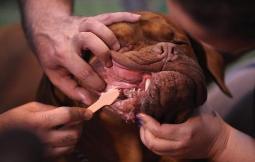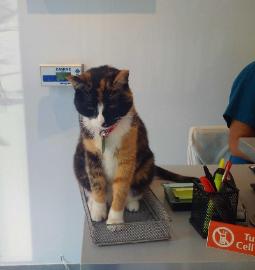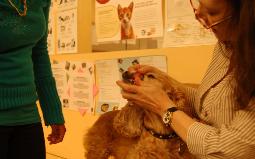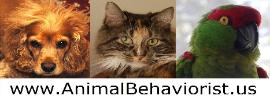
Choosing the right vet for you and your pet |
Choosing the right vet for you and your pet
copyright (c) 2021 Frania Shelley-Grielen. All rights reserved.
When it comes to choosing a veterinarian for your pet you are also deciding on a
professional and a practice that you can feel good about working with. Here's how
to make sure the vet you select is the right one for you and your pet:
With time, some groundwork and a bit of luck you are can find the best partner in
caring for your pets health.
References
Csoltova. E., Martineau, M., Boissy, A., Gilbert, C. (2017). Behavioral and physiological reactions
in dogs to a veterinary examination: Owner-dog interactions improve canine well-being.
Physiology & Behavior, 1(177) 270-281.
This article is an original work and is subject to copyright. You may create a link to
this article on another website or in a document back to this web page. You may not
copy this article in whole or in part onto another web page or document without
permission of the author. Email inquiries to info@animalbehaviorist.us
copyright (c) 2021 Frania Shelley-Grielen. All rights reserved.
When it comes to choosing a veterinarian for your pet you are also deciding on a
professional and a practice that you can feel good about working with. Here's how
to make sure the vet you select is the right one for you and your pet:
- Ask other like minded pet owners which vets they prefer and which they
- do not and why. The Humane Society of the United States and PetFinder.com
suggest asking around for recommendations and opinions on local vets. Every
vet has a different approach as well as different strengths and weaknesses.
Identify what you need in a veterinarian: do they need to treat a variety of
companion animals or be a dog or cat specialist? Is being open to and able to
practice complimentary medicine important? What size facility do you need;
small and personable or up to the minute with the latest technology?
- Are the offices clean? Is the front office staff helpful or off-putting and
- intimidating? Establishing a caring relationship for your pet starts with each
individual you or your pet interacts with being both respectful and
compassionate towards the both of you. PetFinder.com offers additional
questions on the office and staff: "Do they acknowledge you when you walk in
or are you ignored? What is the overall appearance of the clinic? Is it clean?
Odor free? What is the attitude of the staff toward the other clients who may
be present? How about to those on the other end of the phone line? You can
learn a lot by just observing".
- Ask for a tour of the entire facility, including the back. PetFinder.com
- has additional tips: "It is also legitimate to request a tour at a time that is
mutually convenient. There may be times of the day when a tour is not
advisable but your request should be granted at some point". On your tour do
pay extra attention to the condition of the areas not normally in public view;
they should stand up to the same scrutiny the front office does.
- Is appropriate time dedicated to each visit? Do technicians and doctors
- take the time to begin a relationship with you as the authority on your
pet before commencing an exam? An initial conversation should be with
you, your concerns for your pet and inquiry made into your pets temperament
and prior vet experiences. For instance, you should be asked about your pets
health concerns, reason for your visit and how your pet should best be
handled. Remember, you are the advocate for your animal. Your pet cannot
speak-you are their voice.
- Is the veterinarian (and the technicians) good listeners and willing to
- answer questions? CompendiumVet.com urges vets to utilize the ask-tell-ask
technique: "This approach is based on the notion that client education
requires identifying what the client already knows and building on that
knowledge, it shows that you are willing to listen to and negotiate the clients
agenda".
- Any professional approaching your animal should first address the pet
- by name and offer a soft touch before anything else. And if your pet is shy
or fearful, handling should always be done with you present in order to offer
additional assurance to your animal. Your presence is comforting in a stressful
situation. Animals associate most vet visits with intrusive pokes, prods and
painful injections from strangers (all in the name of health but still uncomfort-
able). Keeping surroundings as familiar as possible will also mitigate anxiety
for your pet, a worn article of your clothing placed in your pet carrier will
help to ease fretfulness. The American Association of Feline Practitioners
suggests: "With respectful handling, even fearful cats are often calmer and
easier to work with if at least part of the examination is done within the
bottom half of the carrier" (the one the cat came to the practice in).
- Avoids taking your pet to "the back" -Are you present for routine
- procedures: vaccines, blood draws, etc., or are these done in the back
room? Be extremely wary of the practice keen to whisk your pet away for
routine procedures. While this may be easier for personnel working with your
pet remember that pets at a veterinary practice are often fearful of procedures
and past experiences. Your presence and oversight is necessary for the welfare
of your animal. (I have heard from some vets that when an owner is present
technicians are often gentler in their handling or "under restrain" the pet they
are working with.) A 2017 study found that signs of stress dogs exhibited at
the vet office included increased heart rate and lip licking, these signs were
reduced significantly when their owners were present, petting and talking to
them. In addition to lowering heart rates, owner presence lessened the
number of attempts to jump off the exam table. According to the study:
"owner—dog interactions improve the well-being of dogs during a veterinary
examination."
- The American Association of Feline Practitioners advises vets that performing
these procedures in the exam room "can comfort the client and remove the
fear of the mysterious “back room.” When you remove the cat from the
examination room, your client wonders, “What is being done to poor Fluffy
that couldn’t be done here?” This anxiety worsens if they can hear “yowls”
from their cat or even sounds from dogs and other cats that are also in the
“back.” Always offer to have the client leave the room if they seem uneasy
or uncomfortable, as many are happy to do so. It is better for the client to
leave the room than to increase the cat’s stress moving them to the “back,”
as it can take 10 minutes for a cat to acclimate to a new environment."
- You would not send another family member in your care off for a vaccination
without your hand to hold or your presence in the room. You have the right to
ask these procedures be done in front of you; competent, caring professionals
will be willing to work with you and your pet. Of course, if you cannot stand
the sight of blood or faint at the sight of a needle, please look away and do not
act as if the sky is falling because it isn't.
- Does the vet explain procedures, medications, vaccinations, etc.
- and get your permission before commencing treatment? Make sure you
are clear on and have agreed to what the plan of care is before it is underway.
Vaccinations are always less taxing on your pet when spread over a course of
visits and vet costs add up, find out what is a priority and what can wait if
your budget is too tight.
- If your pet need be hospitalized, does the practice permit visits? The
- College of Veterinary Medicine at Ohio State University advocates visiting as
often as the clinic allows. Make sure the clinic does. Being hospitalized is
extremely stressful for your animal; visiting will offer the comfort so
necessary in supporting your pet during recovery time and healing.
- Make sure the vet provides a thorough physical exam: Some vets will
- skip steps to get to the next patient or because they are fearful of handling an
animal. There are nine basic steps for the exam. Know them so you can make
sure they are provided:
- 1) The technician or vet if there is no tech will first take blood pressure,
temperature, and respiratory rate. The next part of this step is to evaluate
the animal's movement in the room or off the table before touching them.
2) Examine eyes, ears, nose and throat. Along with a visual exam of all, this
includes opening the pet's mouth to look inside the mouth and along teeth and
gums, depressing gums and using an instrument to examine the inside of the
ears.
3) Examine the heart and lungs by listening through a stethoscope.
4) Palpate or touch the abdomen. Palpate kidneys, liver, spleen, internal
lymph nodes, and intestines.
5) Perform an exam of the muscles and skeleton to check for abnormal
walking patterns and deformities. Palpate all joints, and perform an
orthopedic examination to check knees and other joints for cracking
or swelling.
6) Palpate all lymph nodes.
7) Check the covering of the body- the fur and skin by looking for
abnormalities and dehydration (done by tenting or lightly holding the
skin together for a second on the upper back).
8) For intact male dogs and older males dogs only: a rectal exam and
palpation of animal glands should be performed. Cats should not receive
a rectal examination unless they have been x rayed or have ultra sounds
showing prostate enlargement.
9) Perform a basic neurologic examination to test how aware the pet is at
judging objects in space. Dr. Douglas Mader after discussing how a thorough
vet exam is the cornerstone of vet medicine, suggests: "Dropping a cotton ball
and watching the patient follow its movement is an excellent way to evaluate
vision and tracking."
- Not every practice will be a match. Do vote with your feet and make sure
- a complete set of your pets records go with you. If things are not right, do try
and communicate this to your vet. Sometimes differences cannot be resolved
but often simple clear communication is key; the Humane Society writes: "If
you feel that your veterinarian isn't meeting your needs as a client or the
needs of your pet as a patient, it may be time to find a new one. But some-
times simple misunderstandings cause conflicts, which you and your vet
can resolve by talking things out and looking for solutions".
- Make sure the vet you choose is able to establish rapport and respect
- with you. CompendiumVet.com advises vets: A great deal of communication
in small animal practice involves providing information, although this does
not mean that communication should be largely one-way. As your pets
guardian you are the expert on your pet, your careful observation, knowledge
and experience of your companion animal should be relied on as valued
information from your vet. According to the Humane Society: You're doing
more than searching for a medical expert. You're looking for someone to meet
your needs and those of your pet, a doctor who has people as well as animal
skills".
With time, some groundwork and a bit of luck you are can find the best partner in
caring for your pets health.
References
Csoltova. E., Martineau, M., Boissy, A., Gilbert, C. (2017). Behavioral and physiological reactions
in dogs to a veterinary examination: Owner-dog interactions improve canine well-being.
Physiology & Behavior, 1(177) 270-281.
This article is an original work and is subject to copyright. You may create a link to
this article on another website or in a document back to this web page. You may not
copy this article in whole or in part onto another web page or document without
permission of the author. Email inquiries to info@animalbehaviorist.us

Christopher Furlong
| "Establishing a caring relation- ship for your pet starts with each individual you or your pet interacts with being both respectful and compassionate towards the both of you." |
| Request an individual consultation |

copyright Frania Shelley-Grielen
| "Make sure the vet provides a thorough physical exam: Some vets will skip steps to get to the next patient or because they are fearful of handling an animal. There are nine basic steps for the exam. Know them so you can make sure they are provided" |

copyright Frania Shelley-Grielen

info@animalbehaviorist.us
212-722-2509 / 646-228-7813
Website copyright Frania Shelley-Grielen
212-722-2509 / 646-228-7813
Website copyright Frania Shelley-Grielen
| "Are you present for routine procedures: vaccines, blood draws, etc., or are these done in the back room? Be extremely wary of the practice keen to whisk your pet away for routine procedures. While this may be easier for personnel working with your pet remember that pets at a veterinary practice are often fearful of procedures and past experiences. Your presence and oversight is necessary for the welfare of your animal." |
Best viewed in Google Chrome |
AnimalBehaviorist.us is a participant in the Amazon
Services LLC Associates Program, an affiliate
advertising program designed to provide a means
for sites to earn advertising fees by advertising and
linking to Amazon.com.
Services LLC Associates Program, an affiliate
advertising program designed to provide a means
for sites to earn advertising fees by advertising and
linking to Amazon.com.